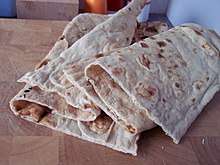Taboon bread
Taboon bread (Arabic: خبز طابون khubz tabun) or laffa (Arabic: لفة) is a Levantine flatbread. It is traditionally baked in a taboon oven or a tannur, and is similar to the various tandoor breads found in many parts of Asia. It is used as a base or wrap in many cuisines, and eaten with different accompaniments.[1] It is of medium thickness, slightly chewy, and does not tear easily.
Taboon bread, main component of musakhan | |
| Type | Flatbread wrap |
|---|---|
| Place of origin | Middle East |
Variations
- Taboon bread is an important part of Palestinian cuisine,[2][3][4] traditionally baked on a bed of small hot stones in the taboon oven.[5] It is the base of musakhan, often considered the national dish of Palestine. German orientalist Gustaf Dalman documented its making in Palestine in the early 20th-century, among other types of breads.[6] In Palestine, folded flat-bread was often filled with a spinach and onion mixture, or with cheese curds and onion mixture, or with raisins and pine nuts.[6] The ordinary taboon-bread was slightly smaller in size than the ordinary tannur-bread.[7] Over the centuries, bread-making in communal taboons played an important social role for women in Palestinian villages.[5]
- It is popular in Israel,[8][9] where it is also called laffa or sometimes "Iraqi pita" (Hebrew: פיתה עיראקית, pita Irakit). It is common at bakeries, and at food stands where it is mostly used to wrap shawarma, falafel, or hummus. Thin saj flatbread is sometimes also referred to as laffa. In Jerusalem, this type of flatbread is also known as eshtanour.[10]
gollark: Twice the die area for worse performance than Nvidia stuff with more difficult programming.
gollark: Their problem isn't anything Moore's-law-y, they just seem to have an awful architecture.
gollark: (this is the only thing I know about topology)
gollark: As any topologist knows, you can have a set which is closed and open at the same time.
gollark: That's still on?
See also
References
- Skloot, Joe (February 28, 2002). "Falafel: Ambassador of peace or cuisine from mideast?". The Daily Princetonian. Archived from the original on 2009-08-19. Retrieved 2018-12-06.CS1 maint: unfit url (link)
- Albala, K. (2011). Food Cultures of the World Encyclopedia. Food Cultures of the World Encyclopedia. Greenwood. pp. 28–29. ISBN 978-0-313-37626-9. Retrieved 2019-10-03.CS1 maint: ref=harv (link)
- Whittemore, William Meynell (1874). Sunshine, conducted by W.M. Whittemore [and others]. p. 6 – via Internet Archive.
- Albala, K. (2016). At the Table: Food and Family around the World: Food and Family around the World. ABC-CLIO. p. 171. ISBN 978-1-61069-738-5. Retrieved 2019-10-03.
- "e-turathuna-Tabun - Bethlehem University". www.bethlehem.edu. Retrieved 2019-02-03.
- Dalman, Gustaf (1964). Arbeit und Sitte in Palästina (in German). 4 (Bread, oil and wine). Hildesheim. pp. 114–115. OCLC 312676221. (reprinted from 1935 edition)
- Dalman, Gustaf (1964). Arbeit und Sitte in Palästina (in German). 4 (Bread, oil and wine). Hildesheim. OCLC 312676221. (reprinted from 1935 edition), Diagram 30
- Nadav, Sarah. "Let's meat at Aish: This off-the-beaten-track restaurant specializes in Eastern-style meats and delicious salads". The Jerusalem Post. Archived from the original on 2018-03-20. Retrieved 2020-01-08.
- "Did You Know? Israeli Cuisine" (PDF). jewishfederations.org. Embassy of Israel, Washington, D.C. 2010-09-04. Archived from the original (PDF) on 2014-11-06. Retrieved 2012-02-13.
- Eating pious pastries in Mea She'arim, Haaretz
This article is issued from Wikipedia. The text is licensed under Creative Commons - Attribution - Sharealike. Additional terms may apply for the media files.
